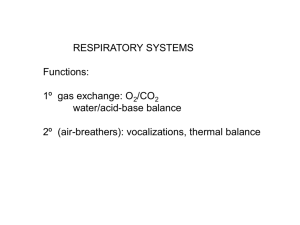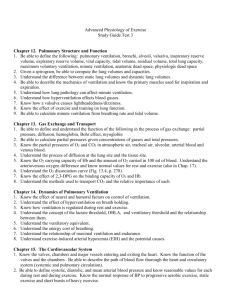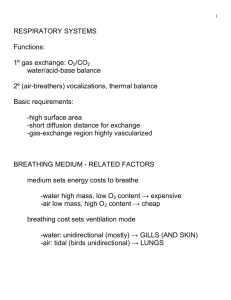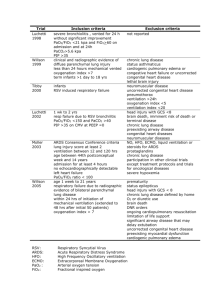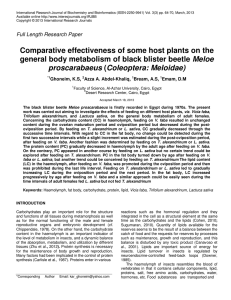ANSWERS TO REVIEW QUESTIONS – CHAPTER 22
advertisement
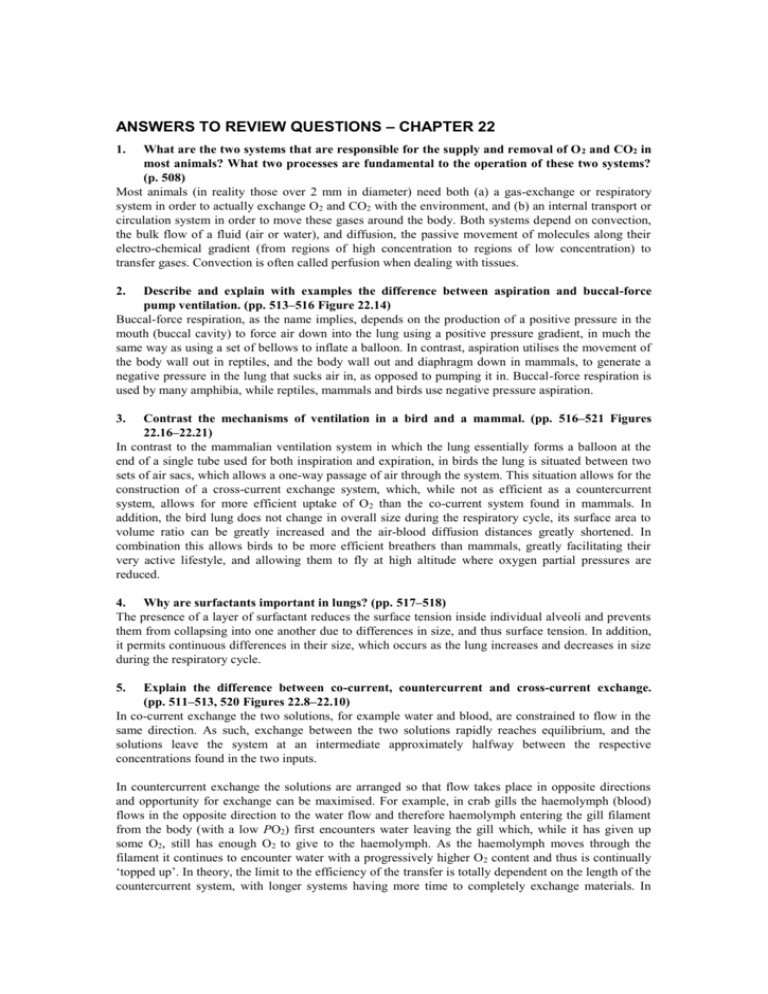
ANSWERS TO REVIEW QUESTIONS – CHAPTER 22 1. What are the two systems that are responsible for the supply and removal of O 2 and CO2 in most animals? What two processes are fundamental to the operation of these two systems? (p. 508) Most animals (in reality those over 2 mm in diameter) need both (a) a gas-exchange or respiratory system in order to actually exchange O2 and CO2 with the environment, and (b) an internal transport or circulation system in order to move these gases around the body. Both systems depend on convection, the bulk flow of a fluid (air or water), and diffusion, the passive movement of molecules along their electro-chemical gradient (from regions of high concentration to regions of low concentration) to transfer gases. Convection is often called perfusion when dealing with tissues. 2. Describe and explain with examples the difference between aspiration and buccal-force pump ventilation. (pp. 513–516 Figure 22.14) Buccal-force respiration, as the name implies, depends on the production of a positive pressure in the mouth (buccal cavity) to force air down into the lung using a positive pressure gradient, in much the same way as using a set of bellows to inflate a balloon. In contrast, aspiration utilises the movement of the body wall out in reptiles, and the body wall out and diaphragm down in mammals, to generate a negative pressure in the lung that sucks air in, as opposed to pumping it in. Buccal-force respiration is used by many amphibia, while reptiles, mammals and birds use negative pressure aspiration. 3. Contrast the mechanisms of ventilation in a bird and a mammal. (pp. 516–521 Figures 22.16–22.21) In contrast to the mammalian ventilation system in which the lung essentially forms a balloon at the end of a single tube used for both inspiration and expiration, in birds the lung is situated between two sets of air sacs, which allows a one-way passage of air through the system. This situation allows for the construction of a cross-current exchange system, which, while not as efficient as a countercurrent system, allows for more efficient uptake of O 2 than the co-current system found in mammals. In addition, the bird lung does not change in overall size during the respiratory cycle, its surface area to volume ratio can be greatly increased and the air-blood diffusion distances greatly shortened. In combination this allows birds to be more efficient breathers than mammals, greatly facilitating their very active lifestyle, and allowing them to fly at high altitude where oxygen partial pressures are reduced. 4. Why are surfactants important in lungs? (pp. 517–518) The presence of a layer of surfactant reduces the surface tension inside individual alveoli and prevents them from collapsing into one another due to differences in size, and thus surface tension. In addition, it permits continuous differences in their size, which occurs as the lung increases and decreases in size during the respiratory cycle. 5. Explain the difference between co-current, countercurrent and cross-current exchange. (pp. 511–513, 520 Figures 22.8–22.10) In co-current exchange the two solutions, for example water and blood, are constrained to flow in the same direction. As such, exchange between the two solutions rapidly reaches equilibrium, and the solutions leave the system at an intermediate approximately halfway between the respective concentrations found in the two inputs. In countercurrent exchange the solutions are arranged so that flow takes place in opposite directions and opportunity for exchange can be maximised. For example, in crab gills the haemolymph (blood) flows in the opposite direction to the water flow and therefore haemolymph entering the gill filament from the body (with a low PO2) first encounters water leaving the gill which, while it has given up some O2, still has enough O2 to give to the haemolymph. As the haemolymph moves through the filament it continues to encounter water with a progressively higher O 2 content and thus is continually ‘topped up’. In theory, the limit to the efficiency of the transfer is totally dependent on the length of the countercurrent system, with longer systems having more time to completely exchange materials. In practice, there are obviously limitations in pipe length and limits to diffusion imposed by the membranes separating the two fluids. Birds possess a cross-current exchange system. While the O2 concentration progressively falls as air moves down the parabronchus, the blind-ended nature of the air capillaries leading off the parabronchus and the fact that their individual blood supplies are mixed on leaving the lung ensure that this is not a true countercurrent system. However, the blood leaving the parabronchus has an O 2 concentration greater than that in the air leaving the parabronchus, showing that the system is far more efficient than a simple co-current exchange. 6. Why are respiratory pigments important? What factors affect the transport of O 2? (pp. 523–525 Figures 22.25–22.29) Oxygen has a relatively low solubility in water and this is further reduced in physiological fluids such as plasma by the presence of salts, etc. The amount that could be carried directly dissolved is thus far lower than needed by the metabolism of the animal. The oxygen-carrying capacity of the blood is improved by binding O2 to respiratory pigments, the main two of which are haemoglobin (without the ‘a’ in American texts) found in vertebrates, and haemocyanin (again without the ‘a’ in American texts) found in molluscs. 7. (a) Explain the reason for the differences in the shape of oxygen equilibrium curves. (p. 524 Figure 22.26) The shape of the oxygen equilibrium curve is dependent on the number of binding sites for oxygen. A single binding site results in a hyperbolic curve, while more than one binding site results in a sigmoidal curve. The more binding sites and the more co-operativity between binding sites, the steeper the curve. (b) What advantages are offered by a respiratory pigment with a steeper curve and a lower P50? (p. 524) The advantage in a pigment having a steep dissociation curve is that such a pigment will change from loading to unloading with a minimal change in oxygen tension. The lower the P50, the lower the ambient oxygen tension at which these changes can occur. For example, the lower P50 of the foetus, compared to the mother, facilitates the transfer of O2 across the placental membranes. 8. (a) Outline the transport of carbon dioxide in mammals. (pp. 525–526 Figure 22.29) In mammals, most CO2 is transported in the form of hydrogen carbonate ion. The chloride shift allows large amounts of hydrogen carbonate to be exchanged between the erythrocytes and the plasma. (b) How does the transport of carbon dioxide affect pH regulation in a mammal? (pp. 525– 526) Most CO2 is hydrated to form carbonic acid, which in turn dissociates and is transported as hydrogen and carbonate ions. This would lead to a dramatic increase in the H + ion level in the blood, giving rise to profound changes in pH. However, haemoglobin acts as a buffer to counteract the increase in H + that occurs. 9. The main gas-exchange organ for water breathers is the gill. Why is it important that gills are ventilated? (p. 527 Figure 22.30) Most gills are protected by a gill chamber. To achieve effective removal of CO 2 and supply of O2, active ventilation is necessary. Ventilation circulates water which has greater O2 levels and lower CO2 levels than the haemolymph at the gill surface, thereby enabling diffusion of the gasses across the gill membrane. 10. Insects adopted a different strategy to other air breathers. What possible problems arose as a result of this strategy in terms of delivering oxygen to the tissues? (pp. 521–523 Figures 22.22–22.23) Insects breath through tracheae, which arise as openings called spiracles. Tracheae taper to a diameter of ca. 0.51 m and deliver O2 to a relatively small area of the cell. As a result, insects require many tracheae across the body surface to ensure adequate ventilation of tissues.



